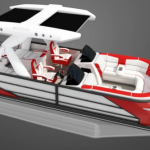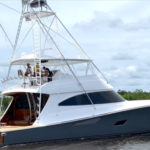Volvo Penta Introduces Self-Docking for Boats
At its headquarters in Gothenburg, Sweden, during the stopover of the Volvo Ocean Race, Volvo Penta demonstrated its self-docking system. A 68-foot yacht fitted with the technology maneuvered itself into a slip between two of the Volvo Ocean Race 65 racing yachts.
The unveiling of the self-docking yacht technology is the latest in Volvo Penta’s ongoing ‘Easy Boating’ philosophy to make boating simple, enjoyable and accessible to more people. At its heart is the joystick-controlled Volvo Penta Inboard Performance System (IPS)*, a complete package from the helm station to the propellers.
The system works can also pull the boat away from the deck during departure. Prototypes of Volvo Penta’s self-docking technology are currently undergoing development trials. The automated docking capability comes due to the onboard electronic vessel control system (EVC), which computes steering and drive calculations in relation to the boat’s actual position and four sensors sited on the intended berth.
“Docking is one of the most challenging boat handling maneuvers – getting it wrong can be embarrassing, expensive and precarious,” says Björn Ingemanson, President of Volvo Penta. “Our IPS system has already taken great strides in making docking easier, and this new self-docking feature takes that process one important stage further. Its sensors and onboard computers react in milliseconds to changing wind and sea conditions, constantly making micro adjustments in power and steering angle of the IPS drive to keep the boat on its intended course into a safe berth.”
Automating the docking process involves three distinct phases. First, as the boat nears its berth, the system recognizes that it has entered a ‘catch zone’ and sends out a signal to the captain that it is ready to dock. Once the captain has activated the self-docking function, the boat is then (aided by GPS), automatically moved into a ‘docking ready’ position. Once the captain has initiated the final stage, the system uses a combination of GPS and sensors, both those fitted onboard and additional sensors fitted to the destination dock to automatically move the boat into a safe berth.
“We have long had the ambition to make docking as easy as possible,” said Johan Inden, Chief Technology Officer at Volvo Penta. “The first step towards this was in 2006, with the launch of our joystick docking technology. This was followed by the introduction of the Dynamic Positioning System, which automatically maintains a boat’s heading and position, even during strong currents or windy conditions. Now, we are taking the next important step by enabling the boat to dock itself.”
The system won’t be available to consumers until 2020. It will be available for the latest IPS equipped boats and it can be retrofit. The initial focus for the self-docking system will be individuals who can install the system on their own private docks. Then Volvo Penta would look to work with marinas and municipal harbors. An additional future scenario for the self-docking system is that it could be integrated with Volvo Penta’s Easy Connect application (app). The app could allow users to check if the nearest marina is equipped with the appropriate self-docking technology.





